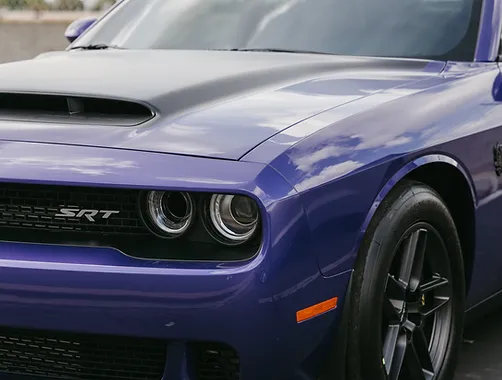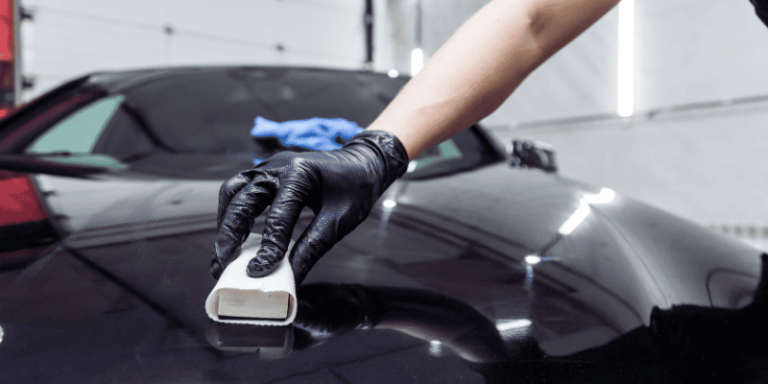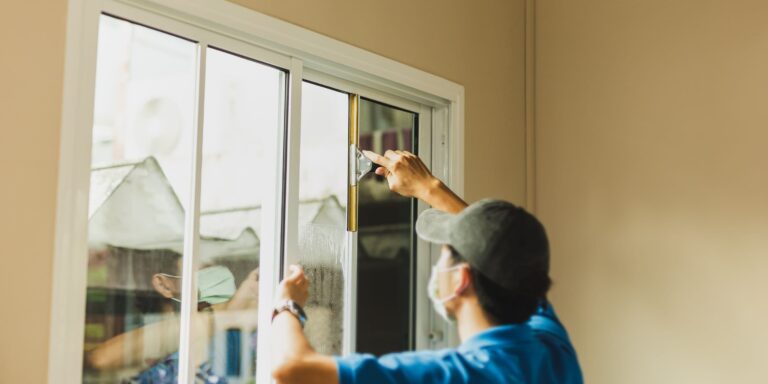Keeping your car’s ceramic coating looking fresh and glossy isn’t as simple as washing it once in a while. Many people believe that once a ceramic coating is applied, their car will stay spotless forever, but that’s far from true. Even the toughest coatings need the right care to keep their shine and protective power intact. Without maintenance, dirt, UV rays, and road contaminants can slowly wear away the coating, leaving the paint exposed. The good news is that maintaining your ceramic coating is easy if you follow a regular routine and understand what works best. This guide will show you exactly how to do that, in a clear, practical way, so your car keeps that deep, mirror-like finish for years.
What Is a Ceramic Coating and Why Maintenance Matters
A ceramic coating is a liquid polymer that bonds chemically with your car’s paint, creating a durable, protective layer. This layer acts as a shield against harmful elements like UV rays, water spots, chemicals, and dirt. However, while ceramic coatings are strong, they are not invincible. Over time, contaminants can stick to the surface, reducing the coating’s hydrophobic effect, that beautiful water-beading property. Regular maintenance ensures that the coating continues to perform at its best, protecting the paint and keeping the gloss alive.
Common Misconceptions About Ceramic Coating
One of the biggest myths about ceramic coatings is that they make your car completely maintenance-free. In reality, coatings reduce how often you need to wash your car but do not eliminate maintenance. Another misconception is that you can use any cleaning product. Many soaps and chemicals can actually strip away the coating or damage its surface. Understanding these misconceptions helps you care for your coating correctly and avoid costly mistakes.
How Ceramic Coatings Work
Ceramic coatings are made of silica dioxide (SiO₂), the same compound used in glass. When applied, they cure and bond at a molecular level with the vehicle’s paint. This creates a slick, hydrophobic layer that repels water and prevents dirt from sticking. Over time, exposure to sunlight, acid rain, and road grime can weaken the coating’s chemical bonds, making it less effective. That’s why washing, decontamination, and occasional boosting are essential for long-term performance.
Why Ongoing Maintenance Is Crucial
Even though a ceramic coating adds years of protection, it’s still exposed to harsh environmental conditions every day. Dust, bird droppings, bugs, and tree sap can sit on the coating’s surface and cause etching or staining. Neglecting regular care will dull the shine and shorten the coating’s life span. On the other hand, consistent maintenance keeps your coating slick, glossy, and water-repellent. Think of it like skincare, a protective layer still needs cleaning and hydration to stay healthy.
What Happens When You Skip Maintenance
Ignoring maintenance can lead to visible dull spots, uneven gloss, and water spots that stick to the coating. The hydrophobic effect may fade, making your car harder to clean. Over time, the coating’s surface may even become contaminated enough to require full reapplication. Proper aftercare prevents this by keeping the coating clear of contaminants and maintaining its ability to self-clean.
Ceramic Coating Warranty and Manufacturer Expectations
Most professional ceramic coatings come with warranties, but these are only valid if you follow the manufacturer’s care instructions. Using the wrong products or skipping maintenance can void your warranty. Many companies require you to perform regular inspections, use specific cleaning methods, and apply maintenance boosters every few months. It’s a good idea to keep records of your washes, boosters, and inspections to maintain your warranty coverage.
Setting a Maintenance Schedule
Your ceramic coating will last longer if you follow a proper schedule. Weekly washes help remove dust and road grime before they stick. A monthly inspection ensures there are no water spots or contaminants forming. Every 3 to 6 months, apply a ceramic booster to refresh the coating’s performance. And once a year, consider a full decontamination or professional inspection.
Maintenance Table Example:
| Frequency | Task | Purpose |
| Weekly | Wash with pH-neutral shampoo | Remove dirt and dust buildup |
| Monthly | Inspect for spots or dull areas | Catch early signs of wear |
| Every 3–6 months | Apply ceramic booster | Restore hydrophobicity and shine |
| Annually | Professional checkup | Deep clean and coating assessment |
Seasonal Adjustments to Your Maintenance Routine
Your car faces different challenges throughout the year, and your maintenance should adapt. In hot climates, UV exposure can dry out the coating faster, parking in shade and using a ceramic topper helps. During winter, road salt and grime can damage the coating’s surface, so rinse the car frequently and apply a booster before the season starts. In humid or rainy seasons, keep an eye out for water spots and clean them quickly before they etch the coating.
Pre-Wash Preparation
Before you begin washing, always start with a pre-rinse. This removes loose dirt and debris that could scratch the coating during washing. Using a foam cannon to pre-soak the car is even better; the foam lifts off grime safely, reducing contact friction. Clean the wheels and lower panels first, as they collect the most contaminants. Always use separate mitts for wheels and paint to avoid cross-contamination.
Choosing the Right Cleaning Products
The wrong cleaning products can harm your coating. Always go for a pH-neutral, wax-free shampoo that’s labeled “ceramic-safe.” Avoid dish soaps or harsh degreasers, they can strip protective layers. Ceramic shampoos are specially formulated to enhance slickness and restore hydrophobic behavior. If possible, use a maintenance kit designed for coated cars, which typically includes shampoo, drying aids, and a booster spray.
Safe Washing Techniques
Use the two-bucket method, one bucket for soapy water and one for rinsing your mitt. This reduces the chance of reintroducing dirt to the paint. Always wash in straight lines instead of circular motions to minimize micro-scratches. Start from the top and work your way down, as dirt settles lower on the car. Use soft microfiber mitts instead of sponges or brushes.
Rinsing the Right Way
After washing, rinse the car with clean water using moderate pressure. If possible, use filtered or deionized water to prevent mineral deposits. Make sure all soap is removed, as leftover residue can affect the coating’s appearance and slickness. Rinse in sections to avoid water drying on the surface before you finish.
Proper Drying Techniques
Drying is just as important as washing. Leaving water to air dry can cause spots, even on ceramic coatings. Use a soft, high-quality microfiber drying towel or a dedicated drying aid spray. Gently drag the towel across the surface, don’t rub. For even safer results, use a car dryer or air blower to push water off without contact. Always dry the car in the shade or indoors to prevent heat from evaporating water too quickly.
Using Ceramic Boosters and Top Coats
Ceramic boosters are products designed to refresh and extend the performance of your ceramic coating. They help restore hydrophobic properties, enhance gloss, and add another layer of UV protection. Over time, the coating can lose its slickness as contaminants bond to the surface. Applying a booster every 3 to 6 months keeps the surface smooth and water-repellent. Boosters also make future washes easier since dirt won’t stick as easily. Think of them as “vitamins” for your coating, they keep it healthy and performing like new.
How and When to Apply a Booster
Before applying a booster, make sure the car is clean and dry. A light decontamination wash using an iron remover or clay alternative may help remove bonded contaminants. Apply the booster in a shaded area and on cool panels only. Spray a small amount onto a microfiber applicator, spread evenly, and buff off any residue with a clean towel. Avoid using too much, a thin, even layer works best. For most cars, reapply every 3 to 6 months, depending on driving conditions and climate.
Removing Contaminants Safely
Even with ceramic protection, your car will encounter tough contaminants like bird droppings, tar, or bug splatter. These should be removed as soon as possible. For example:
- Bird droppings: Wipe with a soft microfiber soaked in detail spray or waterless wash. Don’t scrape.
- Tar or sap: Use a ceramic-safe tar remover or bug remover.
- Iron deposits: Apply an iron fallout remover designed for coated surfaces.
If you notice small rough patches, use a fine-grade clay towel or mitt with a lubricating shampoo, but only if absolutely necessary. Frequent claying can thin the coating over time.
Repairing Micro-Scratches or Dull Spots
No matter how careful you are, micro-scratches can appear on your coating due to improper washing or drying. Avoid using aggressive polishes, as they can cut through the ceramic layer. Instead, use a light finishing polish labeled “coating-safe.” If the coating still looks dull afterward, it might be time for a professional touch-up. A detailer can inspect the coating’s condition, perform a gentle polish, and reapply a new top coat if needed.
Regular Inspections and Coating Performance Checks
Regular inspections help you spot early signs of wear. A simple water-beading test can tell you if your coating is still hydrophobic. Spray water onto the panel, if it forms tight, round beads, the coating is performing well. If the water starts to sheet or stick, it’s time to clean or boost. Also, look for areas that appear dull or grabby to the touch. Keeping a maintenance log, noting wash dates, booster applications, and inspections, helps track performance and warranty compliance.
Mistakes to Avoid During Maintenance
Many coating failures happen because of simple mistakes. Avoid these common errors:
- Washing in direct sunlight: This can cause soap and water to dry too fast, leaving streaks and spots.
- Using automatic car washes: The brushes and chemicals can strip or scratch the coating.
- Using household detergents: They’re too strong and can break down the coating’s layer.
- Skipping drying: Air drying can cause water spots.
- Overusing boosters: Too much product can build up, leaving streaks or haze.
Being gentle, consistent, and patient always pays off when it comes to coating care.
Common Myths About Ceramic Coating Care
Ceramic coating myths can cause confusion and even damage if followed blindly. Let’s clear a few up:
| Myth | Truth |
| Ceramic coatings are maintenance-free | They reduce maintenance, but you still need to wash and boost regularly |
| You can use any car soap | Only pH-neutral shampoos are safe. Harsh cleaners can dull the coating. |
| Boost sprays all work the same. | Some are sealants, others are silica-based. Always choose a product compatible with your coating |
| Washing in sunlight is fine | Sunlight speeds up water evaporation, leading to streaks and mineral spots. |
| Polishing a coated car is safe. | Only very light, coating-safe polishes should be used. Heavy compounds can remove the layer entirely. |
Understanding these myths keeps your coating safe and performing as expected.
FAQs
Q1. Is it safe to wash a ceramic coated car in sunlight?
No. Always wash in the shade or when the car’s surface is cool. Sunlight dries soap and water too quickly, leaving streaks or water spots.
Q2. How often should I reapply a ceramic booster?
Typically every 3 to 6 months, depending on weather, driving conditions, and exposure to contaminants.
Q3. Can I wax over a ceramic coating?
You can, but it’s unnecessary. Most waxes won’t bond properly and can affect hydrophobic behavior. Use ceramic boosters instead.
Q4. Why is my coating losing its shine or water-beading ability?
Contaminants or dirt buildup often block the coating’s surface. A deep wash or iron remover treatment usually restores performance.
Q5. Can I use a pressure washer on a coated car?
Yes, but use moderate pressure (below 1800 PSI) and a wide-angle nozzle to avoid damaging the surface.
Q6. What’s the best way to handle bug splatter or bird droppings?
Clean them immediately using a soft microfiber towel and a ceramic-safe detail spray. The sooner you remove them, the less chance they’ll etch the coating.
Maintenance Plans for Different Drivers
Different driving habits and environments require different maintenance routines:
| Type of Driver | Environment | Suggested Routine |
| Daily Commuter | Urban / Dusty | Wash weekly, booster every 3 months |
| Weekend Car Owner | Garage-kept | Wash biweekly, booster every 6 months |
| Long-Distance Driver | Highway / Rainy | Wash twice weekly, booster every 3 months |
| Hot Climate Driver | Sunny / UV Exposure | Use UV-protectant booster every 3 months |
| Winter Driver | Snow / Salt | Rinse often, booster before winter and after |
These examples help you adjust your care plan based on your car’s lifestyle and environment.
Essential Tools and Product Checklist
Having the right tools makes maintenance easier and safer.
Recommended Tools:
- Microfiber wash mitts and drying towels
- Two or three buckets with grit guards
- Foam cannon or foam sprayer
- pH-neutral ceramic shampoo
- Ceramic booster spray
- Air blower or soft towel for drying
- Iron remover or quick detailer for contamination
Keep your cleaning tools separate for wheels, paint, and glass to prevent scratches.
Final Summary: Keep Your Coating Alive
Maintaining your ceramic coating isn’t about doing more work, it’s about doing it right. Consistent washing, gentle drying, and regular booster applications will keep your coating glossy and strong for years. Avoid shortcuts like automatic car washes or harsh chemicals, and treat your coating with care. The payoff is worth it: an easy-to-clean, brilliant shine that makes your car look freshly detailed every day.




